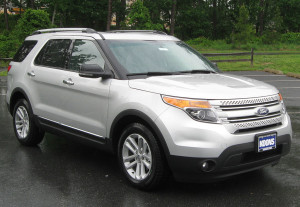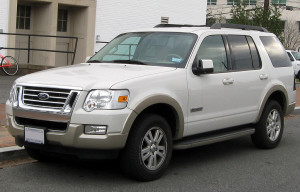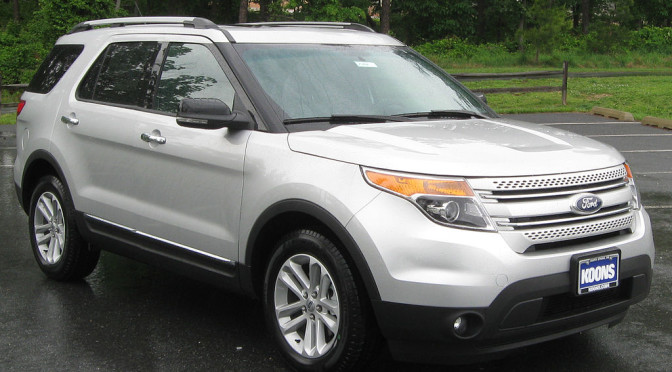The Ford Explorer is one of the most popular 3-row mid-sized SUVs you can buy today in the United States, especially after the release of the fifth generation in 2011. It competes strongly with other 3-row mid-sized crossovers like the Honda Pilot, Toyota Highlander, Dodge Journey, Dodge Durango, Volkswagen Touareg, Hyundai Santa Fe, and its own stablemate the Ford Flex, with which it shares a platform (the D4). The latest Ford Explorer is also, by my estimations, one of the safest SUVs you can be in during a side impact collision, and is a clear demonstration of Ford’s attention to vehicular safety.
Being such a capable SUV, I made it my mission to figure out how well it did when it came to fitting 3 car seats across the 2nd row. The good news is that it’s a wide-enough SUV to theoretically fit 3, 4, or even 5 car seats in; the bad news is that the inflatable seat belts some trim levels currently feature aren’t compatible with a wide range of car seats currently sold, and it also has a number of other potentially frustrating quirks that can make it a difficult vehicle to work with, car-seat wise. We’ll dig into the details in a moment. First, let’s look at which kinds of car seats should be used to keep your kids safe at various ages.
First of all, I like to begin with rear-facing, since it’s the safest position for young children. I suggest rear-facing from day one until you can’t anymore, even if that takes you through the preschool years (ideally until 4!), before forward-facing them in harnessed convertible or combination seats (ideally until at least 6!). Once they outgrow their harnessed seats, it’s best to keep them restrained in high-back boosters until they’re physically and psychologically ready to use adult seat belt systems (which typically happens between 10 and 12). These suggestions may take a bit of extra work, but they provide a lot of extra safety.
My results of car seat puzzling in the Explorer are below. It’s not a complete list, but as with all of my 3 across guides, it’s my goal to make it the most complete on the Internet over time, especially as I get access to more seats. If you find the list helpful when shopping for car seats, you can shop through my Amazon link below. I’ll add more seats as I test them over time.
You can access the complete 3 across guide for every vehicle here and the complete list of recommended seats here. The Canadian car seat guide is here. 3 across car seat images are courtesy of Wikipedia.
 2011, 2012, 2013, 2014, 2015, 2016, 2017 Ford Explorer (U502)
2011, 2012, 2013, 2014, 2015, 2016, 2017 Ford Explorer (U502)
Guaranteed 3 across installations:
Clek Fllo (x3).
Clek Foonf (x3).
Diono Radian R120 (x3).
Diono Radian RXT (x3).
Chicco KeyFit 30 (x3).
Combi Coccoro (x3).
Clek Fllo, Diono Radian / RXT (x2).
Clek Foonf, Diono Radian / RXT (x2).
Graco TurboBooster, Clek Fllo, Diono Radian / RXT.
Graco TurboBooster, Diono Radian / RXT (x2).
Tips and Tricks:
The current generation of the Ford Explorer is 197 inches long and 79 inches wide, which would make you think you’d be able to fit just about any car seats in it. However, despite its size, it can be a very frustrating vehicle for multiple car seat installation. It works very well for 2 car seats at a time, and make no mistake, it can definitely be used with 3 or even 5 car seats at a time if you’ve got the right seats. It’ll just be more difficult in this vehicle than in one with a bit more thought put into the internal design.
The biggest issue you’ll likely find with the Explorer has to do with the inflatable seat belts found in some, though not all, trim levels. To put it simply, unless your car seat specifically states it can be used with those belts, you’ll want to use LATCH instead, which can significantly cut down on the available space for a 3 across installation.
Perhaps the second biggest problem you’re likely to encounter with the current generation of the Explorer is the 2nd row center seat; it’s a very narrow one. However, you can definitely fit narrow seats like the Fllo, Foonf, and the Radians there. The Coccoro will also fit due to its narrowness. That said, you’ll have to battle your way past the huge seat hinges necessary for folding the seat. There are also recessed buckles that can be very difficult to access when trying to get a seat installed there.
A third and fourth issue you might find yourself dealing with is 3rd row access and 1st-row seating space. Because you can’t move the 2nd row seats forward or backward, if you need more space in the 2nd row for rear-facing car seats, you’re going to need to push your front-row seats forward, which can get uncomfortable quickly. Similarly, if you want access to your 3rd row with any degree of frequency, you’ll need to have an infant seat placed on that outboard seat, because if you put a convertible seat there, you’re not going to want to uninstall and install it every single time someone needs to get into or out of the 3rd row.
 2006, 2007, 2008, 2009, 2010 Ford Explorer (U251)
2006, 2007, 2008, 2009, 2010 Ford Explorer (U251)
Guaranteed 3 across installations:
Clek Fllo (x3).
Clek Foonf (x3).
Combi Coccoro (x3).
Clek Fllo, Diono Radian / RXT (x2).
Clek Foonf, Diono Radian / RXT (x2).
Graco TurboBooster, Clek Fllo, Diono Radian / RXT.
Graco TurboBooster, Diono Radian / RXT (x2).
Graco Size4Me 65 (x3).
Graco Contender (x3).
Tips and Tricks:
The 2006-2010 generation of the Ford Explorer is 193 inches long and 74 inches wide, or 4 inches shorter and 5 inches narrower than the following generation. This means that you’re going to have less side-to-side space to work with, but it also means that you’re not going to need to worry about things like inflatable seat belts, so I’d consider this generation to be as car seat friendly as the current generation, if not more.
As usual, consider using the seat belt to maximize side-to-side space when dealing with wider seats.
—
If you find the information on car safety, recommended car seats, and car seat reviews on this car seat blog helpful, you can shop through this Amazon link for any purchases, car seat-related or not. Canadians can shop through this link for Canadian purchases.

